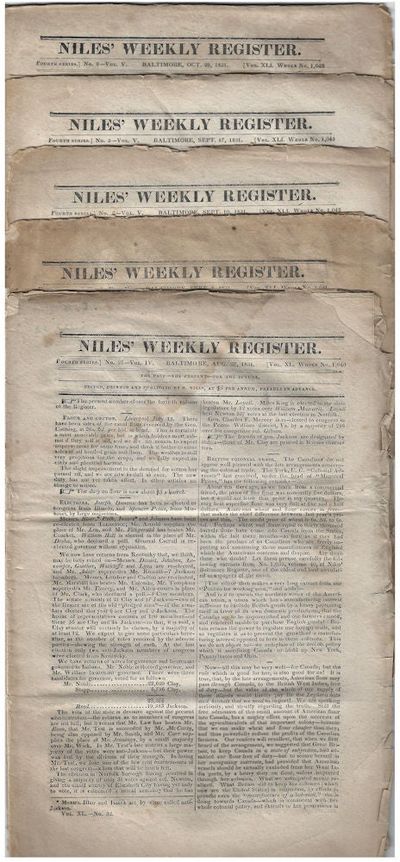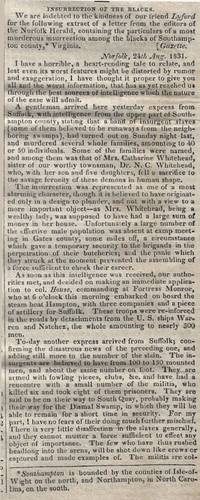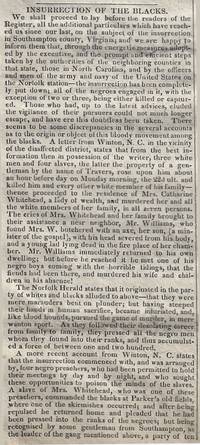1831 – Three months of contemporary newspaper coverage of “The Insurrection of the Blacks,” also known as Nat Turner’s Rebellion
- SIGNED
- Baltimore, Maryland: Niles Weekly Register, 1831
Baltimore, Maryland: Niles Weekly Register, 1831. Very good. This lot includes some of the earliest reporting on Nat Turner's revolt in Southampton, Virginia, which began on 21 Aug 1831. These five issues from the Niles Weekly Register recount the event and together provide an extraordinary contemporary record of the slaughter in which about 40 slaves hacked, stabbed, and clubbed to death 60 white people. Many of the victims were killed in their sleep and most of those killed were women and young children, eleven of whom were students, decapitated after being trapped in a school classroom. All of the issues are complete. None have ever been trimmed or bound, and their fore-edges subsequently show wear. The last four leaves of the 17 September issue appear to have been reattached. The 27 August issue has a light damp stain. The 3 September issue is toned and missing a piece of the lower left corner with no text loss. The 10 September issue’s cover has been reattached and has a 4” tear to two leaves. Overall, the imperfections are rather slight and as a group, these issues are in nice shape.
The 27 August issue, which is especially scarce, devotes 13.5 column inches to the massacre and includes the initial report of the attacks that were published in the Norfolk Herald and the Richmond Whig. It reads in part:
“I have a horrible, a heart-rending tale to relate. . .. A band of insurgent slaves . . . had turned out on Sunday night last, and murdered several whole families. . .. One of the most alarming character . . . it is believed to have originated only in a design to plunder, and not with . . . a more important object as a wealthy lady was supposed to have had a large sum of money in her house. Unfortunately, a large number of [men were] absent at a camp meeting [which] gave a temporary security to the brigands in the perpetration of their butcheries [and] prevented the assembling of a sufficient force to check their career. . ..
“Col. Howe, commanding at Fortress Monroe, . . . embarked on board the steamboat Hampton with three companies and a piece of artillery for Suffolk. . .. The insurgents were believed to have from 100 to 150 mounted men, and about the same number on foot. They are armed with fowling pieces, clubs, &c. and have had a rencontre with a small number of militia, who killed six and took eight of them prisoners. . .. The [perpetrators] will be shot down like crows or captured and made examples of. . ..
The 3 September issue, which is less scarce though still uncommonly found, contains 18 column inches and corrects some errors from the previous week's report as well as providing additional details. It reads in part:
“Through the energetic measures of the authorities . . . and officers and men of the army and navy on the Norfolk station – the insurrection has been totally put down; all of the negroes engaged in it, with the exception of two or three, being either killed or captured. . .. A letter from . . . the vicinity states that . . . three white men and four slaves . . . killed [Mr. Travers] and every other white member of his family. . .. Mr. Williams, who found Mrs. Whitehead butchered with an axe, her son . . with his head severed from his body, and a young lad lying dead in the fireplace of her chamber, . . . immediately returned to his own home [where he found] the fiends had been there, and murdered his wife and children. . .. [The first perpetrators recruited] all the negro men they found into their ranks, and accumulated a force of between one and two hundred.
“A more recent account . . . states that the insurrection commenced with, and was arranged by, four negro preachers, who had been permitted to hold their meetings by day and night. . .. The Southampton militia had three skirmishes with a gang of 40 to 50 negroes, the latter retreating each time. . .. Many of the blacks were well mounted and armed with bird and other guns, and axes. The roads were strewed with the carcases of the negroes killed. . ..
“It [has] hardly been within the power of rumor to exaggerate their atrocities: whole families, father, mother, daughters, sons, sucking babies and school children, were butchered by them, thrown in heaps, and left to be devoured by hogs and dogs, or to putrify on the spot. . ..”
The 10 September issue reports in part:
“The public will not be satisfied with any thing less than the total extermination of the murderers. . .. As oppressed as Virginia is with the tremendous evil of slavery, it is to be expected [that] the white population, in case of like future outrages in the future, will retaliate by an indiscriminate slaughter of the blacks. . ..”
The 17 September issue reports in part:
“The people of lower Virginia and the adjacent parts of N. Carolina, are excessively agitated because of the recent massacre. . .. The Dismal Swamp is to be scoured, for it is said to contain from 2 to 3,000 blacks, and these were in concert with the murders. . .. It is well known that the white people in all this section of the country are arming themselves. . ..
“We hate – without reservation hate, negro slavery, and regard it as the supreme curse of our land. But . . . and this we think certain – that a large majority of the slaves are better fed and clothed, more comfortable and virtuous, than the free negroes, who are the very pests of society in Baltimore, Philadelphia, New York, Providence, &c. [If] humane masters [liberated] their people, [they] would become vagabonds and thieves [rather than] taking care of themselves. . .. Verily, we have enough of them, and our jail, penitentiary and poor house are besides chiefly filled with them. We are willing to bear our own part . . . by supporting the African colonization society. . .. “
The 29 October issue contains a brief note, “’Gen Nat.’ It is believed that this distinguished leader of the blacks at the massacre in Virginia, was drowned, in attempting to cross New River.” . Nat Turner, the educated black preacher who led the massacre, was mistakenly thought have drowned, however he was captured hiding under a pile of fence posts on October 31st. He was tried and convicted in early November and hanged on the 11th. An additional 56 blacks were convicted and hanged as well. Whites also killed approximately 120 blacks without trial, some they believed to have participated in the massacre, some in retaliation for Turner’s atrocities, and some in fear for their lives.
(For more information, by far the best source of information Turner’s rebellion is Ross’s “The Nat Turner Project” available online. Other accurate accounts of the rebellion and its aftermath include Grey’s 1831 transcription of Turner’s confession just before his execution, The Confessions of Nat Turner, the Leader of the Late Insurrections in Southampton, Va., Styron’s novel The Confessions of Nat Turner, and “Nat Turner’s Revolt (1831)” at the online Encyclopedia Virginia. Many modern accounts are questionable at best, and some contain fabricated quotations and events.)
A scarce and historically valuable collection of contemporary newspaper reports of the rebellion as it unfolded. At the time of listing, nothing similar is for sale in the trade. The Rare Book Hub reports the auction of several individual issues. OCLC reports that many libraries hold partial runs of this serial that may or may not include issues pertaining to the rebellion. We sold examples of the 27 August and 3 September issues in similar condition in 2017 for $950. .
The 27 August issue, which is especially scarce, devotes 13.5 column inches to the massacre and includes the initial report of the attacks that were published in the Norfolk Herald and the Richmond Whig. It reads in part:
“I have a horrible, a heart-rending tale to relate. . .. A band of insurgent slaves . . . had turned out on Sunday night last, and murdered several whole families. . .. One of the most alarming character . . . it is believed to have originated only in a design to plunder, and not with . . . a more important object as a wealthy lady was supposed to have had a large sum of money in her house. Unfortunately, a large number of [men were] absent at a camp meeting [which] gave a temporary security to the brigands in the perpetration of their butcheries [and] prevented the assembling of a sufficient force to check their career. . ..
“Col. Howe, commanding at Fortress Monroe, . . . embarked on board the steamboat Hampton with three companies and a piece of artillery for Suffolk. . .. The insurgents were believed to have from 100 to 150 mounted men, and about the same number on foot. They are armed with fowling pieces, clubs, &c. and have had a rencontre with a small number of militia, who killed six and took eight of them prisoners. . .. The [perpetrators] will be shot down like crows or captured and made examples of. . ..
The 3 September issue, which is less scarce though still uncommonly found, contains 18 column inches and corrects some errors from the previous week's report as well as providing additional details. It reads in part:
“Through the energetic measures of the authorities . . . and officers and men of the army and navy on the Norfolk station – the insurrection has been totally put down; all of the negroes engaged in it, with the exception of two or three, being either killed or captured. . .. A letter from . . . the vicinity states that . . . three white men and four slaves . . . killed [Mr. Travers] and every other white member of his family. . .. Mr. Williams, who found Mrs. Whitehead butchered with an axe, her son . . with his head severed from his body, and a young lad lying dead in the fireplace of her chamber, . . . immediately returned to his own home [where he found] the fiends had been there, and murdered his wife and children. . .. [The first perpetrators recruited] all the negro men they found into their ranks, and accumulated a force of between one and two hundred.
“A more recent account . . . states that the insurrection commenced with, and was arranged by, four negro preachers, who had been permitted to hold their meetings by day and night. . .. The Southampton militia had three skirmishes with a gang of 40 to 50 negroes, the latter retreating each time. . .. Many of the blacks were well mounted and armed with bird and other guns, and axes. The roads were strewed with the carcases of the negroes killed. . ..
“It [has] hardly been within the power of rumor to exaggerate their atrocities: whole families, father, mother, daughters, sons, sucking babies and school children, were butchered by them, thrown in heaps, and left to be devoured by hogs and dogs, or to putrify on the spot. . ..”
The 10 September issue reports in part:
“The public will not be satisfied with any thing less than the total extermination of the murderers. . .. As oppressed as Virginia is with the tremendous evil of slavery, it is to be expected [that] the white population, in case of like future outrages in the future, will retaliate by an indiscriminate slaughter of the blacks. . ..”
The 17 September issue reports in part:
“The people of lower Virginia and the adjacent parts of N. Carolina, are excessively agitated because of the recent massacre. . .. The Dismal Swamp is to be scoured, for it is said to contain from 2 to 3,000 blacks, and these were in concert with the murders. . .. It is well known that the white people in all this section of the country are arming themselves. . ..
“We hate – without reservation hate, negro slavery, and regard it as the supreme curse of our land. But . . . and this we think certain – that a large majority of the slaves are better fed and clothed, more comfortable and virtuous, than the free negroes, who are the very pests of society in Baltimore, Philadelphia, New York, Providence, &c. [If] humane masters [liberated] their people, [they] would become vagabonds and thieves [rather than] taking care of themselves. . .. Verily, we have enough of them, and our jail, penitentiary and poor house are besides chiefly filled with them. We are willing to bear our own part . . . by supporting the African colonization society. . .. “
The 29 October issue contains a brief note, “’Gen Nat.’ It is believed that this distinguished leader of the blacks at the massacre in Virginia, was drowned, in attempting to cross New River.” . Nat Turner, the educated black preacher who led the massacre, was mistakenly thought have drowned, however he was captured hiding under a pile of fence posts on October 31st. He was tried and convicted in early November and hanged on the 11th. An additional 56 blacks were convicted and hanged as well. Whites also killed approximately 120 blacks without trial, some they believed to have participated in the massacre, some in retaliation for Turner’s atrocities, and some in fear for their lives.
(For more information, by far the best source of information Turner’s rebellion is Ross’s “The Nat Turner Project” available online. Other accurate accounts of the rebellion and its aftermath include Grey’s 1831 transcription of Turner’s confession just before his execution, The Confessions of Nat Turner, the Leader of the Late Insurrections in Southampton, Va., Styron’s novel The Confessions of Nat Turner, and “Nat Turner’s Revolt (1831)” at the online Encyclopedia Virginia. Many modern accounts are questionable at best, and some contain fabricated quotations and events.)
A scarce and historically valuable collection of contemporary newspaper reports of the rebellion as it unfolded. At the time of listing, nothing similar is for sale in the trade. The Rare Book Hub reports the auction of several individual issues. OCLC reports that many libraries hold partial runs of this serial that may or may not include issues pertaining to the rebellion. We sold examples of the 27 August and 3 September issues in similar condition in 2017 for $950. .




